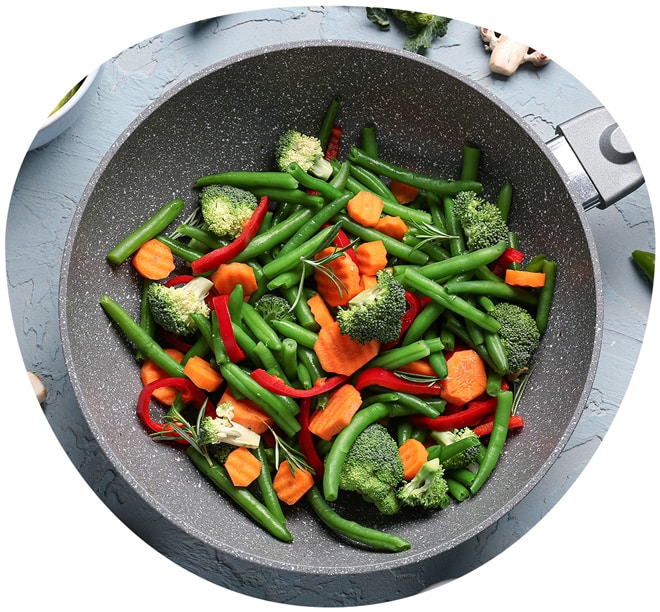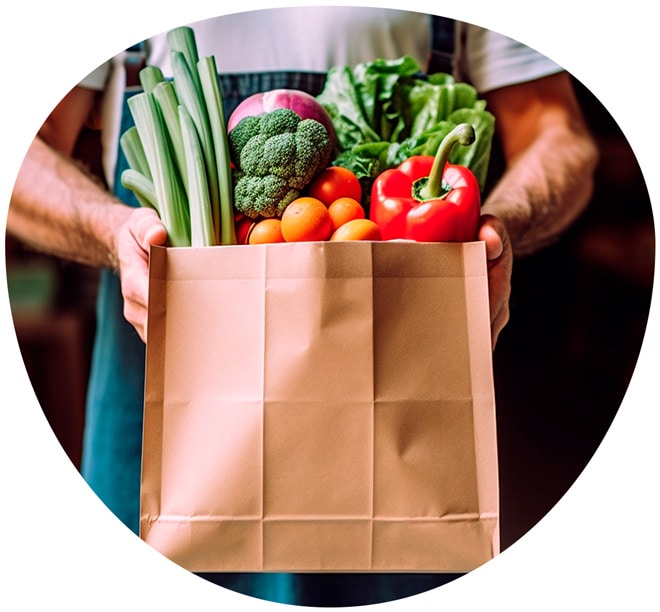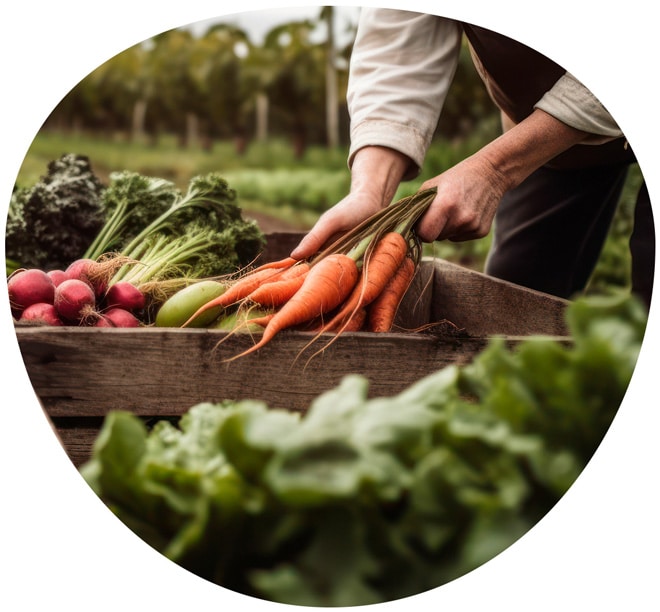
Together for a More Sustainable Tomorrow!
Environmental conservation and combating global climate change are collective social responsibilities. We have taken our share of that responsibility and are actively working towards reducing our carbon footprint while maintaining nature and people at the heart of all our activities.
Our sustainability strategy focuses on implementing clear and thoughtful actions in five main areas, that are commercially successful but at the same time environmentally friendly, fulfil people’s needs.
climate impact
Did you know that the food industry contributes nearly one-third of all global greenhouse gas emissions? We display the climate impact of each product so you can make more informed food choices and support efforts to slow global climate change. Each of us can make a difference!
We use the cradle-to-gate method to calculate climate impact. This means we add up the impacts of raw materials, packaging, transport to the factory and production processes but do not include any activities after the product leaves the factory.
Based on calculations, we know that the greatest impact is not from packaging or production but from raw materials.
We know that a diet that ensures both human and environmental health is possible. In addition to monitoring the climate impact of consumed food, it is also essential to avoid food waste.
Our calculation method and threshold for small climate impact were developed with the assistance of the Swedish research institute RISE. Our assessment scale considers the following:
- the climate impact of an average Nordic citizen’s food consumption (approx. 2 tonnes CO2e per year);
- reasonable daily food consumption (approx. 1.3 kg);
- the need to reduce global climate emissions by 50% compared to 1990 levels to constrain global warming to 1.5°C above pre-industrial levels by the end of the century.
Frequently asked questions
How do you ensure a product has a small climate impact?
We developed the methodology for calculating climate impact and the threshold for small climate impact with the assistance of the Swedish research institute RISE. Preferring small climate impact (<2.1 kg CO2e/kg) foods, while maintaining a reasonable level of daily food consumption (approx. 1.3 kg per person), we could reduce emissions from food by 50%. This aligns with the global goal to reduce climate emissions by 50% by the year 2030 (compared to 1990 levels).
Do you only evaluate climate impact, or do you also consider broader environmental aspects like water usage and biodiversity?
Our assessment scale and methodology focus on climate impact. However, in our work with raw materials, packaging, production processes and product development, we also consider other environmental aspects, but describing them all on a single scale would be too complex.
What is product climate impact?
The climate impact of a product indicates the amount of greenhouse gases, or climate emissions, released into the atmosphere as a result of the particular product. These gases affect the climate by trapping outgoing solar radiation, thus warming the Earth. Different products have varying types and amounts of greenhouse gases released into the atmosphere. Therefore, the climate impact of products varies. Product climate impact is described in terms of carbon dioxide equivalents (CO2e), representing the amount of carbon dioxide that would have the same warming effect as all the greenhouse gases associated with the product.
Where do you get information about the climate impact of your products, and who has reviewed your methodology?
We calculate the climate impact by considering the combined effects of raw materials, packaging, transport to the factory and the production process while not considering activities carried out after the product leaves the factory. Our assessment scale and methodology were developed in collaboration with the Swedish research institute RISE; the same methodology is used across the entire Orkla Group in various countries.
Shouldn’t products with a large climate impact be avoided? Why do you continue to produce them?
A sustainable diet doesn’t necessarily mean exclusively consuming products with a small climate impact. It’s essential to ensure that food provides an adequate amount of nutrients for good health. Balancing nutrition and sustainability is crucial for both human and environmental well-being.
How can smoothies packaged in small plastic containers and containing exotic fruits like mango or banana have a small climate impact?
To calculate the climate impact of products, we consider the combined impact of raw materials, packaging, transport to the factory and the production process of the final product. Our calculations show that raw materials primarily drive the climate impact, while the impact of packaging and transport is generally smaller. Since smoothies are mainly plant-based and have large water content, their climate impact is below 2.1 kg CO2e per kg of product, which is considered the threshold for products with a small climate impact.
Why do you assess all your products on the same scale?
We use the same scale to facilitate comparisons of the climate impact of different products across categories. If we used category-specific scales, we wouldn’t gain a broader understanding of which categories have a smaller climate impact overall.
How can you compare the climate impact of products from different manufacturers?
We’ve only conducted calculations for our own products, as we have the necessary data for them. In our calculations, we’ve observed that raw materials tend to be the main source of impact. Based on our findings, we can infer that products with similar compositions have similar climate impacts. Generally, the more plant-based a product is and the less animal-based it is, the smaller its climate impact, using certified raw materials can also reduce environmental risks. For example, Rainforest Alliance-certified cocoa helps to better address potential environmental risks associated with raw material cultivation, such as deforestation.
When will Orkla sell only products with a small climate impact?
We currently do not have a specific plan in place to exclusively sell products with small climate impact. However, we are committed to ensuring that all our products are produced as sustainably as possible. This can be achieved through collaboration with our raw material suppliers, product and packaging development, and improving the efficiency of our manufacturing processes. At the same time, our diet must provide us with enough nutrients to stay healthy. Striving to meet consumer expectations, we also aim to operate within the planet’s ecological boundaries.
Why do you display a range rather than showing the exact climate impact figure?
While our calculations provide precise numerical values, we opt not to display them due to slight inaccuracies inherent in climate impact assessments. For example, the precise climate impact of raw materials depends on factors like climatic conditions and soil quality. Factors such as batch size and raw material characteristics influence the production process, and transportation impact depends on the type of fuel used. These variables, subject to change over time, contribute to a certain degree of fluctuation in climate impact. Therefore, we believe it is more informative to provide a range indicating whether the climate impact is small, medium or large, rather than displaying a single exact value.
Does Estonians’ diet have a large climate impact?
There are no precise studies or data available regarding the environmental impact of Estonian diets. Therefore, our assessment thresholds (small, medium and large) are based on the average climate impact of Nordic diets. Generally, the environmental impact per capita of diets in low-income countries is smaller than in high-income countries. Additionally, developed countries tend to have more food waste at the consumer level, making their food systems less sustainable. Regardless of comparisons with others, it’s essential for individuals to understand that their diets have an environmental impact that can be influenced through informed choices.
Did you also consider food wastage when developing your assessment scale?
We began with the average climate impact of food consumed by the average Nordic person, regardless of whether it ends up being eaten or discarded. To meet the climate goals for 2030, this impact must be halved. This would ensure that the food system contributes to reducing emissions in line with other sectors, allowing us to limit global warming to 1.5°C by the end of the century compared to pre-industrial levels. The assessment thresholds are determined by considering a sensible daily food intake per person and establishing the climate impact per kilogram of food required to meet our climate objectives. This calculation does not account for additional food waste. Therefore, while preferring products with low climate impact is one step towards a more climate-friendly diet, it is equally important to minimise food waste. Our calculations also factor in wastage occurring during raw material cultivation and production processes, which we continually strive to reduce to decrease product climate impact.
Shouldn’t you also measure your products’ impact on health, alongside environmental impact?
We openly share information about the nutritional value and ingredients of our products (including on the product packaging) to enable consumers to make informed choices. The healthiness of food cannot be easily measured with a single metric. It is often said that there are no inherently healthy or unhealthy foods, but rather healthy or unhealthy diets; seemingly healthy food choices can turn out to be overall unbalanced or unhealthy. The key is balance and variety in diet. The principles of a health-supporting diet can be found on the website of the Estonian National Institute for Health Development at toitumine.ee, which we recommend following.
Why isn’t the “small/medium/large” rating displayed for beverages?
The scale was developed based on the average Nordic diet. To provide a more relevant comparison, all beverages (including milk, coffee, tea, juice, soft drinks and alcoholic beverages) were excluded from the analysis. Therefore, we do not provide a rating for beverages. However, we can still express their climate impact since the calculation methodology remains the same. Just like with foods, we can calculate the combined impact of raw materials, packaging, transport to the factory and the production process at the factory for beverages.
nutrition
Preventing many diseases and improving overall well-being can be achieved through good nutrition and a healthy lifestyle. In Põltsamaa, we also value balanced nutrition. Thus, we have set ourselves the goal of increasing the range of products supporting healthy nutrition and making them a natural preference.
Actually, you don’t need that much salt and sugar
For years, we have been gradually reducing the amount of added sugar and salt in our products. Compared to 2015, our juice drinks contain 12% less added sugars. That’s 60 tons less sugar over five years! However, our sugar reduction process hasn’t stopped. We continue this gradual reduction. By 2025, our goal is to decrease the sugar content in our juice drinks by 15%.
Vegetable pickles and preserves are also under review
We consistently review the ingredients of our vegetable preserves. Compared to 2015, we have reduced sugar in their composition by 5%, its 6 tons less sugar than before.
No mountains of salt
In comparison to 2015, we have reduced the added salt in our ready-made meals by 18%, approximately 1 ton less than before.
We have no intention of reducing the taste and value of our food
We focus on ensuring that our meals are balanced in nutritional value while remaining delicious and nutritious. Our jarred soups and meals contain a variety of vegetables, helping to fulfill the ‘5 handfuls’ rule and provide daily contributions to fiber and minerals. We involve experts in our product development (e.g., Fitlap, Estonian Chefs’ Association), thereby supporting the promotion of a healthier lifestyle in society.
No preservatives
Põltsamaa ready-made meals are made without artificial additives and flavor enhancers. Safe packaging and the production that meets the highest quality standards, ensure the great taste and food safety of our ready meals – thus, there’s no need for preservatives! Additionally, we regularly review our heat treatment regimes in production to ensure a fresher taste while maintaining food safety.
So Delightfully Light
We have made our fried cabbage series lighter by replacing lard with rapeseed oil. This significantly reduced saturated fatty acid content and further decreased the use of animal-derived ingredients where unnecessary.
We’re Not Just About Fixing Things
When developing new products, we already consider salt, sugar, and fat content in the initial development phase. Additionally, we focus on developing value-added products.

production

Food production is resource-intensive. Fortunately, adopting circular economy practices and continuously innovating our processes, provides the oportunity to preserve valuable natural resources for as long as possible.
Our Specialists are Top-Notch
We continuously improve our production and identify areas where more energy can be saved and/or recycled. We engage top-notch specialists and use a digital energy monitoring system.
100% green electricity
All the electricity used in our production is 100% green energy, mainly sourced from hydro, wind, and solar power.
Less carbon dioxide
The thermal energy used in production comes from the boiler house. In 2021, a thorough renovation increased its efficiency by almost a tenth. As an additional action, in 2022, we plan to switch from oil shale to natural gas. The increase in efficiency and transition to natural gas together reduce our carbon dioxide footprint by 30%, which is about 1000 tons less per year compared to before.
Organic-waste reduction
We’re addressing the reduction of organic waste. Compared to 2016, we have reduced organic waste from 950 tons to 650 tons, about 30%. For instance, some time ago, we introduced a new steam peeler, reducing the loss from peeling by 50%.
Little things matter too
Through various smaller improvements, such as replacing air compressors and installing heat recovery ventilation, we have collectively reduced 1600 MWh of heat in our production, about 500 tons of CO2.
packaging
We package food to protect the product, extend its shelf life, and reduce food waste. However, we understand that every package has its environmental impact and carbon footprint. Therefore, we work daily to reduce this impact.

raw materials

The food value chain accounts for 25% of the world’s greenhouse gas emissions and 70% of freshwater consumption. Engaging in ensuring decent work and by addressing the reduction of environmental impacts associated with agricultural production, we can truly make a difference in the world.
Taking Care of Our Own
We emphasize the importance of ensuring the well-being of people, animals and the environment in the cultivation of raw materials for our production. Our goal is always to procure the freshest and finest ingredients from where they naturally thrive. We utilize local resources as extensively as possible.
We engage in close collaboration with local farmers who have been our long-term partners, growing and evolving with us. Providing them with support and training when needed, we’ve organized farm visits and training trips to Germany and Finland to explore new ideas and modernize production.
Areas Where We Don’t Compromise
We assess all our suppliers not only for food safety but also from a sustainability standpoint. We require adherence to the Orkla Supplier Code, covering workers’ rights, occupational health care and safety, saving the environment, fair business practices and corporate management principles.
Where Does Our Food Really Come From
Our pumpkins, cabbages, potatoes, beets, and carrots are sourced entirely from local Estonian growers. While most of our cucumbers and zucchinis come from local farmers, a small portion is imported. Throughout the year, we purchase nearly 5000 tons of various vegetables from farmers.
The raw materials for our juices primarily come from Spain, Italy, Greece, and Brazil, as these regions the juiciest fruits ripen under the sun. In juice production, we utilize both -not from concentrated and concentrated juices and purees. Transporting concentrated raw materials helps reduce resource consumption in transportation, warehousing and packaging, which is beneficial for the environment.
Our jams are produced in one of Orkla`s most modern jam factories in Denmark and bottled jams in Sweden, following Põltsamaa`s recipes. We use sustainable sugar of European origin that meets the Farm Sustainability Assessment (FSA) silver level, a widely recognized assessment method.